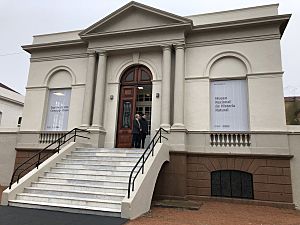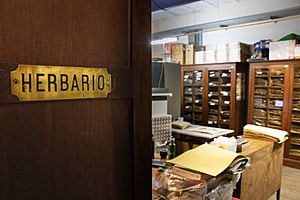National Museum of Natural History, Uruguay facts for kids
| Museo Nacional de Historia Natural | |

Main entrance
|
|
| Lua error in Module:Location_map at line 420: attempt to index field 'wikibase' (a nil value). | |
| Established | 1838 |
|---|---|
| Location | Miguelete 1825, 11800 Montevideo, Uruguay |
| Type | Natural history museum |
The National Museum of Natural History (also known as MNHN) in Montevideo, Uruguay, is a special place where you can learn all about nature and science. It's a natural history museum, which means it shows us amazing things from the natural world, both from long ago and today.
This museum first opened its doors in 1838. This makes it the oldest science-focused place in Uruguay. It also has one of the oldest collections of natural history items anywhere in the world.
Today, the museum has a main exhibition area at Miguelete 1825. This building used to be a prison called Miguelete Prison. The museum's huge collections, its library, and its offices are located at Calle 25 de Mayo 582 in the Old City.
Contents
History of the Museum
How the Museum Started
In September 1837, the government of Uruguay decided to create a national library and a museum. They put together a group of people to make this happen. Dámaso Antonio Larrañaga was chosen to lead this group.
Soon after, the group went on an exciting trip in December 1837. They dug up a fossil of a glyptodon from the banks of the Pedernal River. A glyptodon was a huge, armored animal that lived long ago. The museum officially opened on July 18, 1838. It was located in what is now called Plaza Zabala.
This museum is even older than some very famous museums. For example, it opened before the American Museum of Natural History (1871) and the Natural History Museum in London (1881).
Changes Over the Years
In 1840, a poet named Francisco Acuña de Figueroa became the museum's director. For a while, people weren't as interested in the museum, and it didn't grow much. Some of its collections even got smaller.
In 1870, the government took back control of the museum. New rules were made in 1875. These rules said that the director had to take good care of the museum's collections. They also had to organize them and report on how the museum was doing.
The museum moved several times. From 1867 to 1878, it was at Calle Sarandí 472. Then, in 1879, it moved to the Solís Theatre. It stayed there until the year 2000. In 1880, the National Library and the National Museum became separate places.
Splitting into Different Museums
The museum kept changing and growing. In 1888, a new group was formed to help organize it better. Then, in 1890, another reorganization happened. This is when the National Museum started to split into different parts.
The science part became the National Museum of Natural History. The parts about art and history became the National History Museum and the National Museum of Visual Arts. This split became official in 1911. The name "National Museum of Natural History" was first used in a law in 1913.
In 1915, the museum received a very important gift. It got a collection of 7,000 dried plant samples, called a herbarium, from a former director, José Arechavaleta. It also received 1,500 books from his private library. This herbarium is still a very important part of the museum's collections today.
Finding a New Home
The space in the Solís Theatre was not big enough for the museum by 1902. But the museum stayed there until 2000. The theatre was being fixed up, so the museum had to move temporarily. It moved to a former bookstore, and then in 2006, to an old auction house.
For many years, the museum didn't have any permanent exhibits open to the public. However, its collections were still available for scientists to study.
In July 2018, the museum finally opened its first permanent exhibition space. This new home is on the grounds of a former prison called Cárcel de Miguelete. The museum shares this space with the Contemporary Art Space (EAC).
The prison was used from 1888 to 1986. It is the oldest "panopticon" prison still standing in Latin America. A panopticon prison is designed so that a single guard can watch all the prisoners from one central spot. The new museum space was opened to celebrate the museum's 180th anniversary.
Museum Collections and Operations
What You Can See and Learn
The museum has a huge collection of items from the natural world. Its plant collection alone has about 80,000 different samples. The museum also has thousands of mammals, birds, fish, molluscs (like snails and clams), arachnids (like spiders), and many other creatures.
Besides the natural specimens, the museum's library holds over 250,000 books!
When the museum opened its new permanent exhibition in the former Miguelete Prison, it had two main displays. One was about prehistoric life in what is now Uruguay. The other was about the present-day ecology of Uruguay, which is how living things interact with their environment.
Discovering Ancient Rodents
In 2008, scientists at the museum made an exciting discovery. They had a skull that had been at the museum since the 1980s. They realized it belonged to a new species of rodent! This new species was named Josephoartigasia monesi.
It was named after Álvaro Mones, a former director of the museum and a paleontologist (a scientist who studies fossils). This giant rodent is the largest known rodent species ever! Scientists believe it weighed up to 1,000 kilograms (about 2,200 pounds). It lived between 2 and 4 million years ago. The genus name Josephoartigasia honors José Gervasio Artigas, a national hero of Uruguay.
Museum Publications
The museum also shares its scientific findings through various publications. The "Annals" of the museum were first published in 1894. Since then, the museum has published many other scientific papers. These include "Botanical Communications" (since 1942), "Zoological Communications" (since 1943), "Anthropological Communications" (since 1956), and "Paleontological Communications" (since 1970). They also have "Extra Publications" that come out sometimes.
From 1973 to 1985, the museum even published a "Bulletin of the National Museum of Natural History" that was given to schools for free.
Directors of the Museum
Many people have led the museum over the years. Here is a list of those who have served as director:
- Dámaso Antonio Larrañaga (1837)
- Teodoro Vilardebó (1837–1840)
- Francisco Acuña de Figueroa (1840–?)
- Mariano Augusto Fabián Ferreira (1868–?)
- Juan Mesa (1888–1890)
- Carlos Berg (1890–1892)
- José Arechavaleta (1892–1912)
- Garibaldi José Devincenzi (1912–1942)
- Ergasto H Cordero (1942–1951)
- Diego Legrand (1951–1970)
- Miguel Ángel Klappenbach (1970–1984)
- Héctor S. Osorio (1984–1998)
- Álvaro Mones (1998–2004)
- Arturo Toscano (2004–2009)
- Víctor Scarabino (2009–2013)
- Javier Alfredo González García (2013–present)
See also
 In Spanish: Museo Nacional de Historia Natural de Uruguay para niños
In Spanish: Museo Nacional de Historia Natural de Uruguay para niños
- Dr Carlos A. Torres de la Llosa Natural History Museum, another important natural history museum in Montevideo
- Lucrecia Covelo, an associate curator and entomologist who works with insects.


